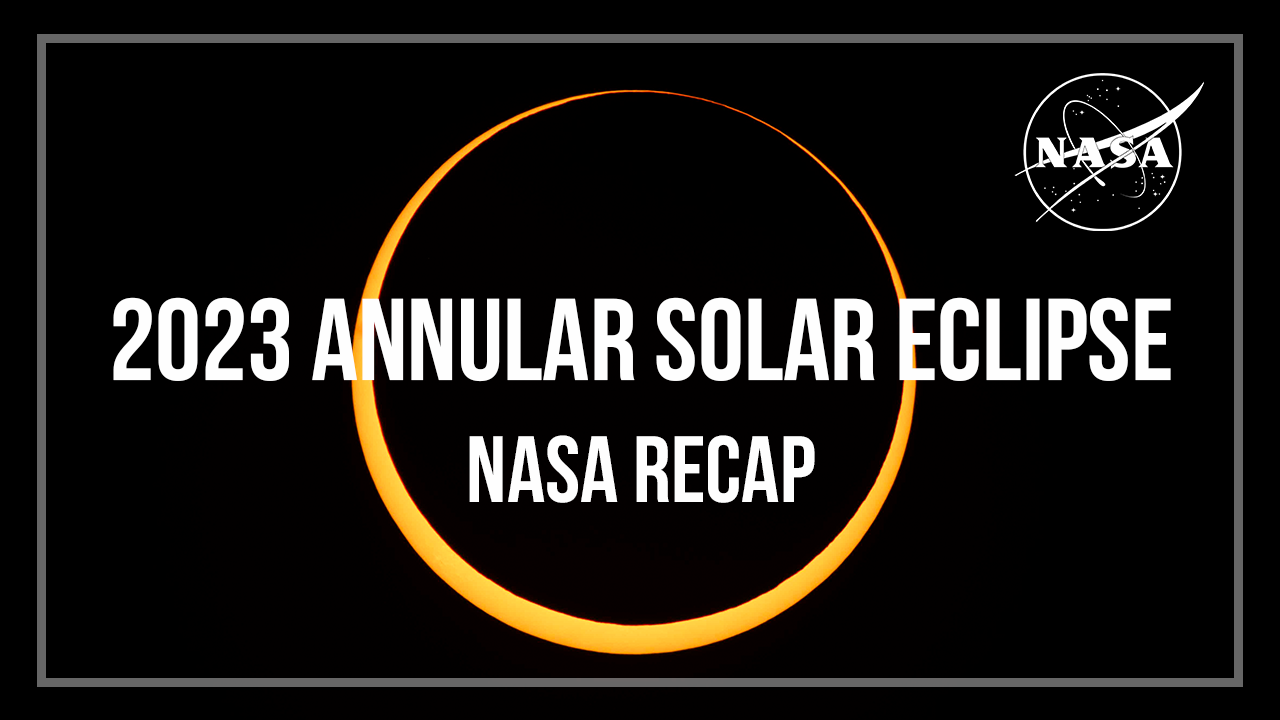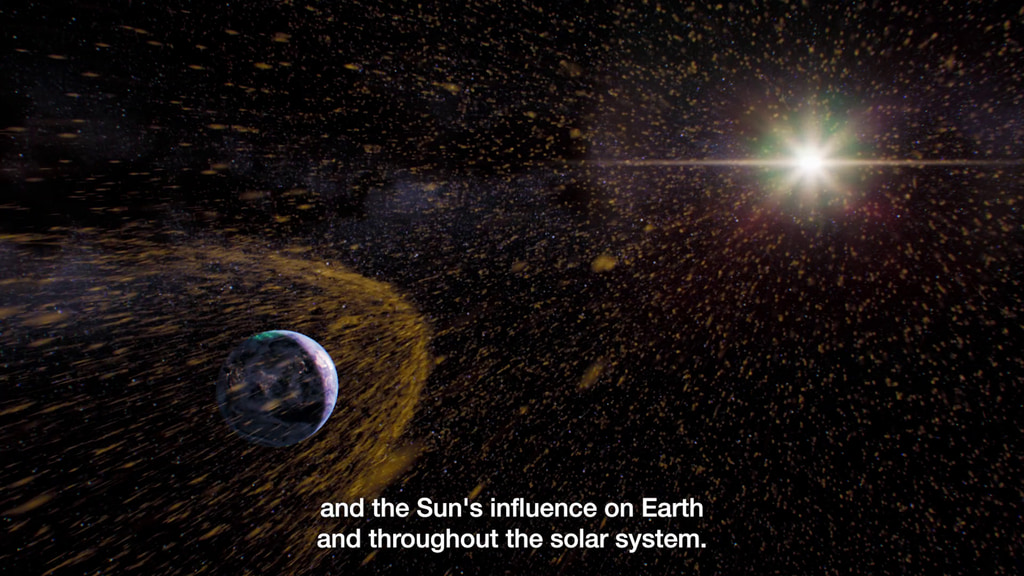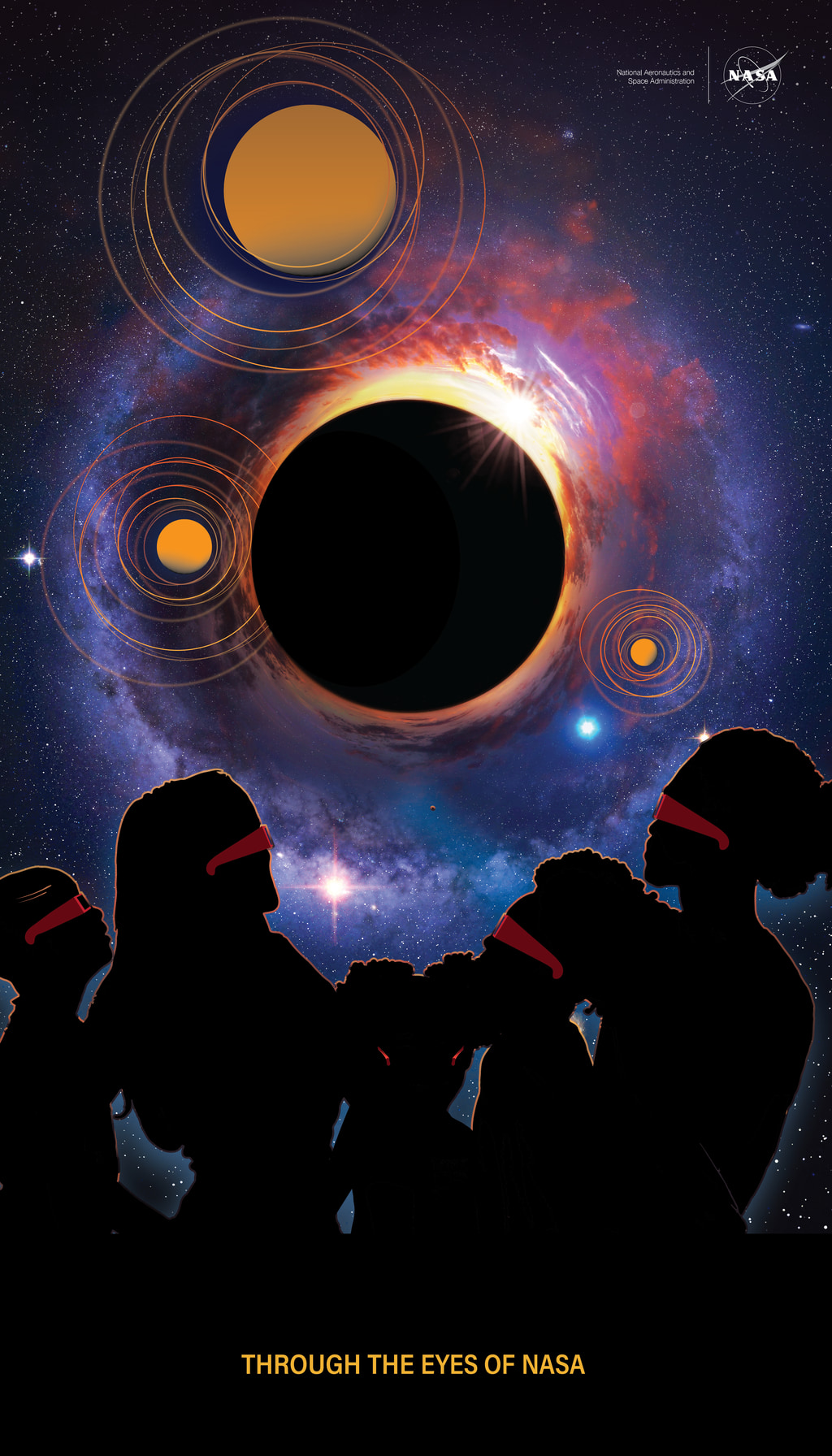2023 Annular Solar Eclipse
Overview
On Oct. 14, 2023, an annular solar eclipse will cross North, Central, and South America. Visible in parts of the United States, Mexico, and many countries in South and Central America, millions of people in the Western Hemisphere can experience this eclipse.
An annular solar eclipse happens when the Moon passes between the Sun and Earth while it is at or near its farthest point from Earth. Because the Moon is farther away from Earth than usual, it appears smaller than the Sun and does not completely cover the star. Because of this, the Sun will appear like a “ring of fire” in the sky for those in the path of annularity.
During an annular eclipse, it is never safe to look directly at the Sun without specialized eye protection designed for solar viewing.
Learn more about this annular solar eclipse: solarsystem.nasa.gov/eclipses/2023
What is an annular solar eclipse?
NASA Annular Eclipse Imagery
Go to this pageOn Oct. 14, 2023, an annular solar eclipse crossed North, Central, and South America. Visible in parts of the United States, Mexico, and many countries in South and Central America, millions of people in the Western Hemisphere experienced this eclipse.An annular solar eclipse happens when the Moon passes between the Sun and Earth while it is at or near its farthest point from Earth. Because the Moon is farther away from Earth than usual, it appears smaller than the Sun and does not completely cover the Sun's disk. Because of this, the Sun will appear like a “ring of fire” in the sky for those in the path of annularity.During an annular eclipse, it is never safe to look directly at the Sun without specialized eye protection designed for solar viewing.To learn more about eclipses visit: science.nasa.gov/eclipses. ||
What Is an Annular Eclipse?
Go to this pageOn Oct. 14, 2023, an annular solar eclipse will cross North, Central, and South America. Visible in parts of the United States, Mexico, and many countries in South and Central America, millions of people in the Western Hemisphere can experience this eclipse. But what is an annular eclipse? Why does it happen? And why does it create a “ring of fire” in the sky? ||
Solar Eclipse Animation Elements
Go to this pageDue to their relative scale and distances, the disks of the Sun and the Moon appear to be almost the same size in the sky when standing on Earth. This means that even though the Moon is much smaller than the Sun, it can block most or all of the Sun's light, resulting in a dark shadow over Earth called a solar eclipse.These videos are designed to help describe some of the dynamics that determine how solar eclipses work and why they are important for those of us living on Earth. ||
The Ring of Fire: 2023 Annular Solar Eclipse (NASA Recap)
Go to this pageOn Oct. 14, 2023, an annular solar eclipse crossed North, Central, and South America. Visible in parts of the United States, Mexico, and many countries in South and Central America, millions of people in the Western Hemisphere were able to experience this “ring of fire” eclipse. NASA’s official broadcast and outreach teams were located in Kerrville, TX, and Albuquerque, NM, to capture the event and celebrate with the communities in the path of annularity. For more information: • Official NASA Broadcast• Interactive Eclipse Map Explorer ||
Annular Eclipse Path
The 2023 Annular Solar Eclipse
Go to this pageThe path of annularity and partial contours crossing the U.S. for the 2023 annular solar eclipse occurring on October 14, 2023. || eclipse_map_2023_QR_1920.png (1920x960) [3.4 MB] || eclipse_map_2023_QR_10800.png (10800x5400) [77.3 MB] || eclipse_map_2023_QR_5400.png (5400x2700) [23.1 MB] || eclipse_map_2023_QR_1920_searchweb.png (320x180) [111.9 KB] || eclipse_map_2023_QR_1920_thm.png (80x40) [7.2 KB] || eclipse_map_2023_QR.png (22500x11250) [129.8 MB] || the-2023-annular-solar-eclipse.hwshow [302 bytes] ||
The 2023 and 2024 Solar Eclipses: Map and Data
Go to this pageThe map was updated on March 15, 2023, to correct times in Mexico along the total eclipse path. ||
Annular Eclipse Safety
How to Safely Watch an Annular Eclipse
Go to this pageOn Oct. 14, 2023, an annular solar eclipse will cross North, Central, and South America. Visible in parts of the United States, Mexico, and many countries in South and Central America, millions of people in the Western Hemisphere can experience this eclipse.Eclipses are a wonderful experience, but it’s important to carefully follow safety procedures. During an annular eclipse, there is no period of totality when the Moon completely blocks the Sun. Therefore, it is never safe to look directly at the annular eclipse without proper eye protection specially designed for solar viewing. Do not use standard binoculars or telescopes to watch a solar eclipse without safe solar filters attached to the front of the device. Regular sunglasses are NOT safe for attempting to look directly at the Sun. ||
Find Out if Your Eclipse Glasses Are Safe
Go to this pageHow can you tell if your eclipse glasses are safe? With the annular solar eclipse just around on the corner on Oct. 14, 2023, here is a quick and easy way to make sure your eclipse glasses are safe to use.When watching an annular eclipse directly with your eyes, you must look through safe solar viewing glasses (“eclipse glasses”) or a safe handheld solar viewer at all times. Eclipse glasses are not regular sunglasses – no matter how dark, sunglasses are not safe for viewing the Sun.To learn more about eclipse safety, visit: http://go.nasa.gov/EclipseEyeSafety ||
Annular Eclipse Safety GIFs with Nicola Fox
Go to this pageOn Oct. 14, 2023, an annular solar eclipse will cross North, Central, and South America. The Sun is never completely blocked by the Moon during an annular solar eclipse. Therefore, during an annular eclipse, it is never safe to look directly at the Sun without specialized eye protection designed for solar viewing.These GIFs, featuring Nicola Fox, associate administrator for NASA’s Science Mission Directorate, can be used as reminders for safe solar viewing this October.Learn more about how to safely watch the annular solar eclipse: https://solarsystem.nasa.gov/eclipses/2023/oct-14-annular/safety/ ||
How to Make a Box Pinhole Projector
Go to this pageWant to view a solar eclipse but don’t have eclipse glasses? No problem! An easy way to safely view a solar eclipse is with a box pinhole projector. With a few simple supplies, you can create a safe and fun way to experience the magic of an eclipse from anywhere. Watch this how-to video to see just how easy it is! ||
Solar Eclipse Safety Images
Go to this pagePeople watch a partial eclipse in Belfast, Northern Ireland, on Mar. 20, 2015. Credit: Robin Cordiner || RobinCordiner.jpg (926x618) [118.5 KB] || RobinCordinerlg_print.jpg (1024x683) [681.3 KB] || RobinCordinerlg.jpg (7065x4715) [22.0 MB] || RobinCordinerlg_searchweb.png (320x180) [98.8 KB] || RobinCordinerlg_web.png (320x213) [114.5 KB] || RobinCordinerlg_thm.png (80x40) [6.7 KB] ||
Heliophysics Big Year
Introducing the Heliophysics Big Year
Go to this pageIn October 2023, NASA is launching the Heliophysics Big Year – a global celebration of solar science and the Sun’s influence on Earth, our solar system, and beyond. Modeled after the “Big Year” concept from citizen scientists in the bird-watching community, the Heliophysics Big Year challenges everyone to get involved with Sun-related activities. The Heliophysics Big Year begins in October 2023 and runs through December 2024. ||
The Heliophysics Big Year
Go to this pageThe Heliophysics Big Year is a global celebration of solar science and the Sun’s influence on Earth and the entire solar system.During the Heliophysics Big Year, you will have the opportunity to participate in many solar science events such as watching solar eclipses, experiencing an aurora, participating in citizen science projects, and other fun Sun-related activities.Join us from October 2023 to December 2024!go.nasa.gov/HelioBigYear ||
Sunday Experiment Featuring Heliophysics
Go to this pageOn Sunday, May 21, 2023, the Goddard Visitor Center featured heliophysics - the study of the Sun and its effects across the solar system - as part of the Sunday Experiment series. Activities included solar viewing using Sunspotters, Solarscopes, and solar glasses. Make your own Ultraviolet bead bracelet and Sun art. Attendees enjoyed disscussions and a question-and-answer session with heliophysics subject matter experts as well as eclipse videos playing on a loop throughout the day. ||
Eclipse Flyers
Annular Solar Eclipse Flyers
Go to this pageOn Oct. 14, 2023, an annular solar eclipse will cross North, Central, and South America. Visible in parts of the United States, Mexico, and many countries in South and Central America, millions of people in the Western Hemisphere can experience this eclipse. ||
NASA’s Eclipse Art
Go to this page“The greatest scientists are artists as well.” ~Albert EinsteinArt and science have been treated as separate disciplines but have more in common than is often realized. Creativity is critical to making scientific breakthroughs, and art is often an expression (or product) of scientific knowledge. And both art and science begin in the experience of awe, of beholding something grand. The experience of a solar eclipse is a prime example of where these two human endeavors meet.Eclipses are celestial events we can predict with extreme precision, and their occurrence reveals fundamental truths about our place in the universe. Yet, as many eclipse watchers will attest, there is no anticipating how you will feel when experiencing one. The emotional resonance of eclipses is underlined by their presence in artforms in cultures across the world going back millennia.To celebrate the special role of eclipses in connecting art and science, creatives across NASA will be sharing their eclipse-inspired artwork in anticipation of two solar eclipses that will cross the United States on October 14, 2023, and April 8, 2024.The first two pieces in the series are presented below, with short biographies of their creators. ||

![Credit: NASA's Goddard Space Flight CenterMusic: "Insect Village" by Anthony Donje [PRS] from Universal Production MusicComplete transcript available.](/vis/a010000/a014300/a014325/14325_AnnularEclipseExplainer_FB.00120_print.jpg)




![VERTICAL VersionMusic Credit: “Tall Grass” by Jacob Paul Turner [BMI], Marc Pueschl [GEMA], Sebastian Barnaby Robertson [BMI] via Universal Production MusicComplete transcript available.](/vis/a010000/a014300/a014390/AnnularEclipseSafety_Thumbnail-VERTICAL_print.jpg)
![Watch this video on the NASA Goddard YouTube channel.Complete transcript available.Music credit: “Easy Breezy” by James Alexander John Welland [PRS] and Thomas Trueman [PRS] from Universal Production Music.](/vis/a010000/a014300/a014395/14395_AreYourEclipseGlassesSafe_Thumbnail.jpg)

![Watch this video on the NASA Goddard YouTube channel.Except during the brief phase of totality during a total solar eclipse, you should never look directly at the Sun without proper eye protection specially designed for solar viewing. Do not use standard binoculars or telescopes to watch a solar eclipse without safe solar filters attached to the front of the device. Regular sunglasses are NOT safe for attempting to look directly at the Sun.Music Credit: “Happy Strut” by Dan Phillipson [PRS] via Universal Production MusicAdditional Graphics: Vecteezy.com, Motionarray.comComplete transcript available.](/vis/a010000/a014300/a014391/14391_Thumbnail.jpg)

![Credit: NASA's Goddard Space Flight CenterWatch this video on the NASA Goddard YouTube channel.Music: “Nanofiber” by Andrew Michael Britton [PRS], David Stephen Goldsmith [PRS]; “Climbing the Ladder” by Jose Tomas Novoa Espinosa [BMI] via Universal Production MusicComplete transcript available.](/vis/a010000/a014300/a014392/14392_Thumbnail.jpg)



